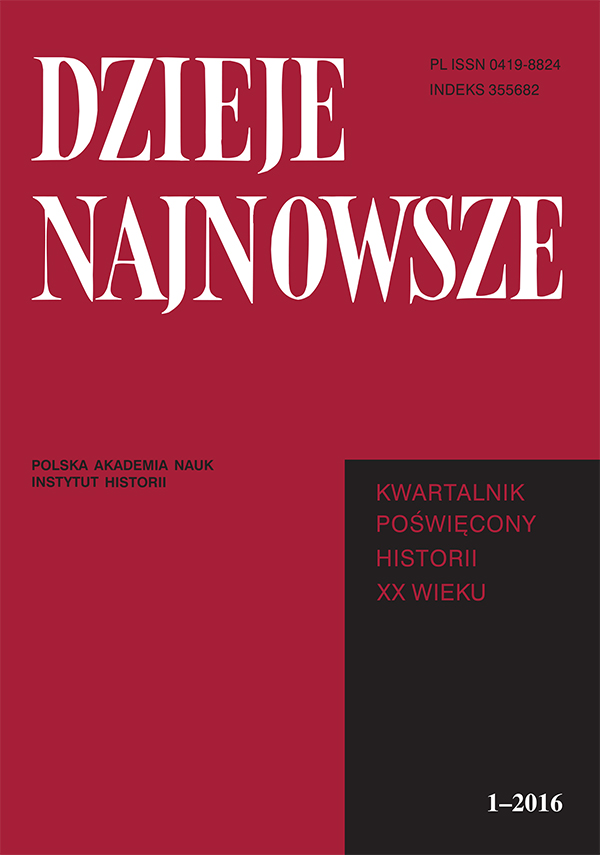Zbrodnia wołyńska 1943 roku i mit buntu ludowego
DOI:
https://doi.org/10.12775/DN.2016.1.04Słowa kluczowe
OUN, UPA, Zbrodnia Wołyńska (The Volhynian Massacre), genocyd, czystka etniczna (ethnic cleaning)Abstrakt
The Volhynian Massacre of 1943 and the Myth of a Peasant Revolt
The discussion about the events, which took place in Volhynia in 1943, includes a hypothesis presenting the anti–Polish outbreaks as an expression of a spontaneous revenge of the local Ukrainian peasants for the discrimination experienced at the time of the Second Republic. The author of the article based himself on unknown documents to demonstrate that in reality the mass–scale massacre of the Poles was organized by the Organization of Ukrainian Nationalists–Bandera (OUN–B) Underground and the Ukrainian Insurgent Army (UPA) partisan units it commanded. The peasants participating in the events were mobilised (at least partly by force) to special auxiliary detachments, ordered by the Bandera–led superiors to set fire to Polish settlements and to kill their inhabitants. Both in Volhynia and in Galicia peasants were incorporated into groups attacking localities inhabited by the Poles, despite the fact that partisan forces sufficed to destroy them. The victims were cruelly murdered with axes and other tools so as to produce the impression among the observers that they were dealing with a local Jacquerie while in reality the massacre was a planned ethnic cleansing campaign. The idea to resolve the Polish–Ukrainian territorial controversy with the assistance of an ethnic purge had been devised by the OUN already prior to 1939. Initially, it was assumed that the future Ukrainian state would be devoid of all landowners and colonists who settled down in the conflict–ridden terrains after 1918, but in time the opinion calling for ”ejecting” the entire Polish population became increasingly popular. The population in question was to be murdered at least partly by the incited local peasants. At the beginning of 1943 UPA detachments commenced a battle against the Germans and Soviet partisans while simultaneously initiating the so–called anti–Polish campaign. The organised de–Polonisation operation, inaugurated on 9 February 1943 by attacking the village of Parośle in Volhynia, lasted until 18 May 1945 and claimed the lives of about 100 000 victims.
Bibliografia
Wydawnictwa źródłowe
Bulba–Boroweć T., Dokumenty, statti, łysty, Kyjiw 2011.
Litopys UPA, t. XXVI, Toronto–Lwiw 2001.
Kołodzinśkyj M., Nacionalistyczne powstania. Rozdił iż praci „Wojenna doktryna ukrajinśkych nacionalistiw”, w: „Ukrajina Moderna” 2014, nr 20.
Nacistskaja polityka gienocida i „wyżiennoj ziemli” w Biełorussii 1941–1944, red. W. Łobanow, Minsk 1984.
Polacy i Ukraińcy pomiędzy dwoma systemami totalitarnymi 1942–1945, w: Polska i Ukraina w latach trzydziestych–czterdziestych XX wieku. Nieznane dokumenty z archiwów służb specjalnych”, t. IV, Warszawa–Kijów 2005.
Ściborskyj M., OUN i seljanstwo, Praha 1933.
Opracowania
Chlebowski C., „Wachlarz”. Monografia wydzielonej organizacji dywersyjnej Armii Krajowej: wrzesień 1941–marzec 1943, Warszawa 1983.
Dulić T., Utopias of Nation. Local Mass Killing in Bosnia and Herzegovina 1941–1942, Uppsala 2005.
Hory L., Broszat M., Der kroatische Ustascha Staat 1941–1945, Stuttgart 1964.
Hryciuk G., Przemiany narodowościowe i ludnościowe w Galicji Wschodniej i na Wołyniu w latach 1931–1948, Toruń 2005.
Hud’ B., Ukraińcy i Polacy na Nadnieprzu, Wołyniu i w Galicji Wschodniej w XIX i pierwszej połowie XX wieku. Zarys historii konfliktów społeczno–etnicznych, Lwów–Warszawa 2013.
Huk B., Ukraina. Polskie jądro ciemności, Przemyśl 2013.
Licina D., Dossier Artukovic, Zagreb 1996.
Motyka G., Od rzezi wołyńskiej do akcji „Wisła”. Konflikt polsko–ukraiński 1943–1947, Kraków 2011.
Nijakowski L. M., Rozkosz zemsty. Socjologia historyczna mobilizacji ludobójczej, Warszawa 2013.
Robionek B., Croatian Political Refugees and the Western Allies. A Documental History, Berlin 2010.
Siemaszko E., Ludobójcze akcje OUN–UPA w lipcu 1943 r. na Wołyniu, w: Antypolska akcja OUN–UPA. Fakty i interpretacje, red. G. Motyka, D. Libionka, Warszawa 2003.
Siemaszko W., Siemaszko E., Ludobójstwo dokonane przez nacjonalistów ukraińskich na ludności polskiej Wołynia 1939–1945, t. I–II, Warszawa 2000.
Sowa A. L., Stosunki polsko–ukraińskie 1939–1947, Kraków 1998.
Torzecki R., Polacy i Ukraińcy. Sprawa ukraińska w czasie II wojny światowej na terenie II Rzeczypospolitej, Warszawa 1993.
Zajączkowski M., Ukraińskie podziemie na Lubelszczyźnie w okresie okupacji niemieckiej 1939–1944, Lublin–Warszawa 2015.
Zajcew O., Ukrajinśkyj integralnyj nacjonalizm (1920–1930–ti roky). Narysy intelektualnoji istoriji, Kyjiw 2013.
Zajcew O., Wojenna doktryna Mychajła Kołodzinśkoho, „Ukrajina Moderna” 2014, nr 20.
Pobrania
Opublikowane
Jak cytować
Numer
Dział
Statystyki
Liczba wyświetleń i pobrań: 807
Liczba cytowań: 0



